Lightning strikes depot at Malaysia??? YAU MOU GAU....CHOR!!!
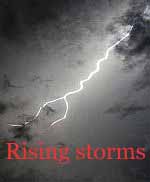
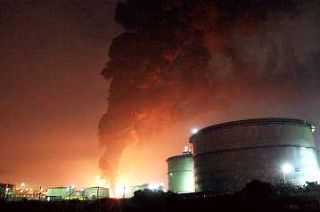
JOHOR BARU: Lightning struck and caused a massive inferno at the Johor Port in Pasir Gudang that could be seen 10km away and from across the straits in Singapore.
The bolt came during an evening thunderstorm, striking a tank that held nearly 90,000 litres of petrol.
When the sparks flew, two bigger tanks – with a total capacity of about 700,000 litres – also went up in flames.
All the tanks were situated at the Petronas Dagangan Bhd fuel depot, with two tanks holding petrol meant for Petronas service stations in the southern region while the other stored jet fuel to be supplied to the Sultan Ismail International Airport at Senai.
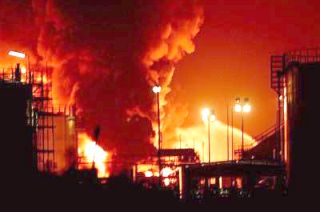
No casualties were reported in the 6.20pm incident but by midnight the first tank was completely razed and more than 100 firefighters were attempting to stop the blaze from spreading to a fourth tank.
This was the latest in a series of lightning strikes across the nation this month that had destroyed property and claimed lives. Two earlier incidents also occurred in Johor.
On April 8, two anglers were struck by lightning as they were fishing from a fishing platform in the waters off Tanjung Langsat.
Three days later in Pontian, a 29-year-old Indonesian worker, working on a fishing platform, was struck dead by lightning.
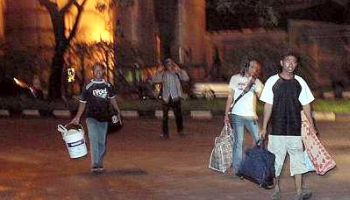
In Penang, a fisherman was killed on April 15 while his friend escaped unhurt when they were struck by lightning about two nautical miles off the Kuala Sungai Pinang coast in Balik Pulau.
On April 25, a motorcyclist was killed on the spot when he was truck by lightning near Taman Mantau Jaya in Seremban.
The next day, a thunderstorm wreaked havoc in the Klang Valley, causing flash floods and bolts of lightning that killed a construction site worker in front of the Amcorp Mall in Petaling Jaya and sparked a fire at a bungalow in Jalan Semantan, Kuala Lumpur.
In yesterday’s port fire, the lightning first struck at Tank No. 14 in the Petronas depot, and then spread to Tank No. 15, about 10m away, which held more than 450,000 litres of petrol.
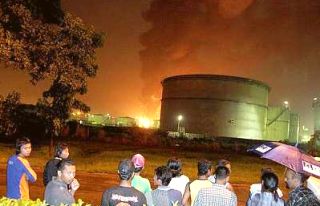
The fire then spread to Tank No. 16, about 2m away, which held 250,000 litres of jet fuel.
By midnight Tank No. 14 had collapsed and firemen were trying to prevent the flames from spreading to storage Tank No. 7, which held more than three million litres of fuel.
The Petronas depot housed at least 15 tanks of various sizes and holding different types of fuel, including petrol, jet fuel and palm oil.
The nearest housing estate, Taman Mawar, is 2km away and curious onlookers came out of their homes to watch the red skies that loomed above Pasir Gudang.
The tanks, it is learnt, have heat protectors but no lightning protectors.
When the fuel storage tanks went up in flames, at least three explosions rocked the port area.
Reporters standing about 1km away heard a loud explosion at about 11.15pm but no immediate information on its source could be obtained then.
Petronas Dagangan issued a statement later to say that the Fire and Rescue Department and the authorities had secured the perimeters of the depot for safety reasons.
Petronas Dagangan assured its customers that supply to the service stations and its other customers would not be disrupted as the company has made arrangements for the products to be sourced from other depots.
Besides the firemen from the port, Johor Baru and nearby Permas, there were also volunteer firefighters from nearby factories.
Most of the port workers rushed out when the emergency sirens went off.

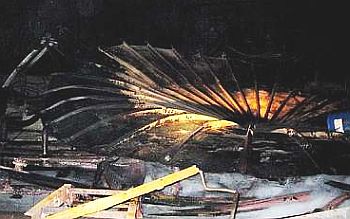
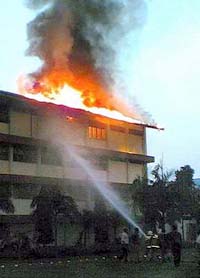
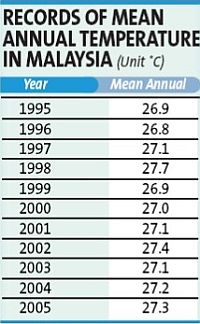
More stormy days for next few months
PETALING JAYA: The recent violent storms and killer lightning are linked to the country's rising temperature that has increased by 0.8°C in the last 35 years, experts said.
As the mercury rises, more moisture gets into the atmosphere and this feeds the normal storm clouds that gather in a tropical country like Malaysia.
Environmentalist Gurmit Singh said indications shown by the climatic changes resulting in weather extremes were also related to the La Nina period.
“These are the chain reaction resulting from the changes in the weather as it is all part of rising temperature or global warming.
“As we can see, the extreme weather like flash floods are causing disruptions to traffic, inconvenience to the public and damage to premises and homes,” said Gurmit Singh who is also executive director of the Centre of Environment, Technology and Development Malaysia.
Malaysian Meteorological Department director-general Dr Yap Kok Seng agreed that the rise in temperature could alter the weather pattern in the long term.
“These are the chain reaction resulting from the changes in the weather as it is all part of rising temperature or global warming.
“As we can see, the extreme weather like flash floods are causing disruptions to traffic, inconvenience to the public and damage to premises and homes,” said Gurmit Singh who is also executive director of the Centre of Environment, Technology and Development Malaysia.
Malaysian Meteorological Department director-general Dr Yap Kok Seng agreed that the rise in temperature could alter the weather pattern in the long term.
“These are the chain reaction resulting from the changes in the weather as it is all part of rising temperature or global warming.
“As we can see, the extreme weather like flash floods are causing disruptions to traffic, inconvenience to the public and damage to premises and homes,” said Gurmit Singh who is also executive director of the Centre of Environment, Technology and Development Malaysia.
Malaysian Meteorological Department director-general Dr Yap Kok Seng agreed that the rise in temperature could alter the weather pattern in the long term.
“It has been accepted that the greenhouse gases effect can cause severe weather becoming more severe,” he said .
Statistics provided by department shows that the average mean temperature plotted since 1970 to 2005 had increased from 26.5 to 27.3°C.
The storms accompanied by lightning have already claimed lives, damaged properties and caused massive floods.
Dr Yap said the present extreme weather could also be caused by the 20 to 30 years' cyclical weather changes.
He pointed out that based on records, this year was expected to be wetter than last year.
“The inter-monsoon season started in March and we are expecting to see unusual high rainfall pattern,” Dr Yap said, warning that it could get worse in the next few months.
Dr Yap said the wet weather was now hitting the North Central and Central of peninsular Malaysia.
A spokesman for the department's forecast unit said the atmospheric condition “is conducive to the formation of thunderstorm clouds”.
He added that the presence of light wind throughout the day also adds to the configuration of cumulonimbus clouds in the evening, heralding heavy rain with lightning and thunderstorms.
Related Stories:
Need to address rise in temperature
Lightning struck school, too
Good for dams, bad for landfills
Comment:
THE WAR OF THE WORLD is live!
What shall we do???








0 Comments:
Post a Comment
<< Home